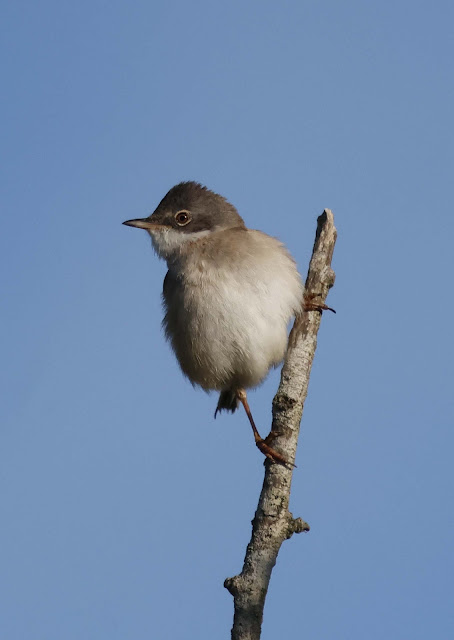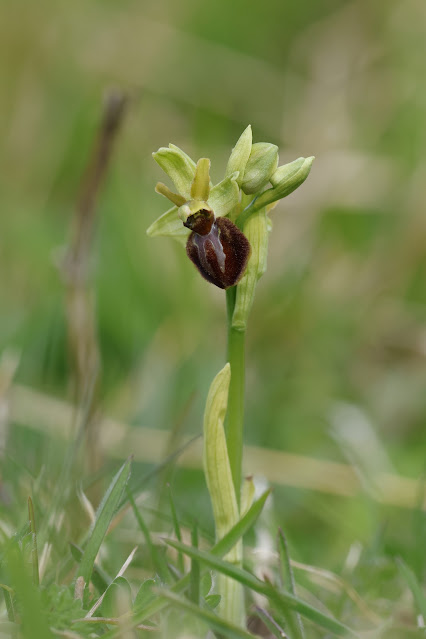Fired with enthusiasm I resolved to head for Pinkhill early the next morning and of course there was neither sight nor sound of a gropper.
These Spring days with bird migration in full swing I am at Farmoor Reservoir virtually daily and on a dull overcast Tuesday I was wandering up the causeway when Dave, a fellow Farmoor regular sent me a text advising a Grasshopper Warbler was showing really well in a ditch full of dead umbellifer stems by the approach road to the northwestern end of the reservoir and Pinkhill.
Finally a movement, low in the thickest part of a maze of dead stems betrayed the bird, perching low down in the ditch. It was not there for long as it was promptly chased off by a territorial Sedge Warbler and fled further along the ditch and disappeared under the rank grass at the bottom. Frustration and no little cursing on my part was directed at the Sedge Warbler.
.jpg) |
| The ditch frequented by the Grasshopper Warbler |
And so it went on as an intermittent procession of dog walkers, joggers and workmen came past at crucial moments.It seemed as if a curse had been put on me that every time I saw the bird well someone would arrive at the critical moment to scare the bird away. My frustration grew and grew until it got the better of me after a couple of hours and I departed in a huff.
Fast forward to Wednesday. A day of gale force, cold southwest wind that threatened to blow me off the reservoir causeway. I decided to try the ditch in the forlorn hope it might be more sheltered from the wind but it was only marginally so, although even above the roar of the wind I could just about hear the gropper reeling but finding it in the swaying stems and gusting wind was a hopeless task and I left it at that.
Not willing to throw in the towel and give up, I checked the weather forecast for the next day I was encouraged to see the wind was predicted to die away to virtually nothing overnight.I formulated a plan to leave the house at 6am and get to the ditch by 6.30am before the dog walkers or anyone else appeared and hope the warbler would perform.
There were a lot of if's and but's and uncertainty to my plan, however if it did work it could be rather good and gropper redemption would be mine to savour. Would lady luck and a bit of planning be on my side?
I parked in the road of houses that backs onto the reservoir and took the tarmac track that leads to the reservoir gate and Pinkhill Lock.
It was very cold and I was thankful I had put on warm clothes. A clear night had allowed a light frost to coat the grass but the rising sun was promising a lovely morning. The cold air reacting with the warmer water of the nearby river had formed a bank of low lying mist, that drifted like wood smoke from the river across the fields and rank vegetation, creating a faint fuzziness to the scene before me.I was not worried as the sun, newly risen, bright and golden, would soon burn away the mist and shadows.
The stage was set and now required the star performer to make an entrance and bring some undoubted glamour and glitz to complement an atmospheric landscape that was far from quiet as a cacophony of birdsong filled the still air, seeming to come from every hawthorn and blackthorn bush. It was an urgency of warbler song, the numerous whitethroats and sedge warblers, newly arrived from Africa competing to be the loudest and most vociferous.The air fairly rang with their energetic outpourings as they sang at full throttle to attract a mate.
All well and good but from the gropper there was not a sound. For ten minutes I stood a little forlorn but defiantly optimistic and for once my hopes were realised as a familiar but faint metallic sounding, high speed, non stop trilling came from the ditch. Instantly energised I approached to where the sound issued, deep in the ditch.Not a dog walker in sight. I reckoned I had about twenty minutes before the first dog walker arrived, just me and the gropper and a host of its migrant warbler friends.
This time the bird was almost immediately visible, perching higher than it had at any time before on a dead stem. Its buff breast, illuminated almost to whiteness by the first rays of the sun reaching the ditch, betraying it amongst the dark stems. In typical fashion it moved its head from side to side. its bill wide open to reveal a pale yellow gape as it poured forth its extraordinary insect like song.
Gaining confidence over the next two hours I approached the gropper more closely and it would allow me to get within about eight metres without showing alarm but any closer and it dropped into the grass and threaded its hidden way underneath. I was close enough at times to note that its whole body, especially its tail, vibrated as it sang with a wide open bill, the mandibles held firm and non moving as the song emerged from its throat. Another feature observed from close range were its bright pink legs and feet, the elongated delicate toes no doubt adapted to aid its mouse like existence running across the ground and through grass.I have seen similar feet on a vagrant Pechora Pipit on Shetland, another haunter of rank grass and vegetation.
The song when heard close has a peculiar mechanical tone and is delivered at high speed creating an insect like reeling sound that is ventriloquial. Although it can sing throughout the day as this one did they sing most frequently at dawn and dusk.
Grasshopper Warblers breed from Spain and France right across northern Europe to Scandinavia and western Russia.They migrate to spend the winter in northern parts of tropical Africa south of the Sahara. Currently they are Red Listed under IUCN criteria and despite declining due to loss of habitat in both their winter and summer ranges, they still have an estimated population of 840,000-1.2 million breeding pairs and so are currently designated of Least Concern.
s


.jpg)
-DeNoiseAI-standard.JPG)
.jpg)



-DeNoiseAI-standard.JPG)
.JPG)
.JPG)
.JPG)
.JPG)
.JPG)

-DeNoiseAI-standard.JPG)








.jpg)



.JPG)
.jpg)












.jpg)
.JPG)


.JPG)


.jpg)